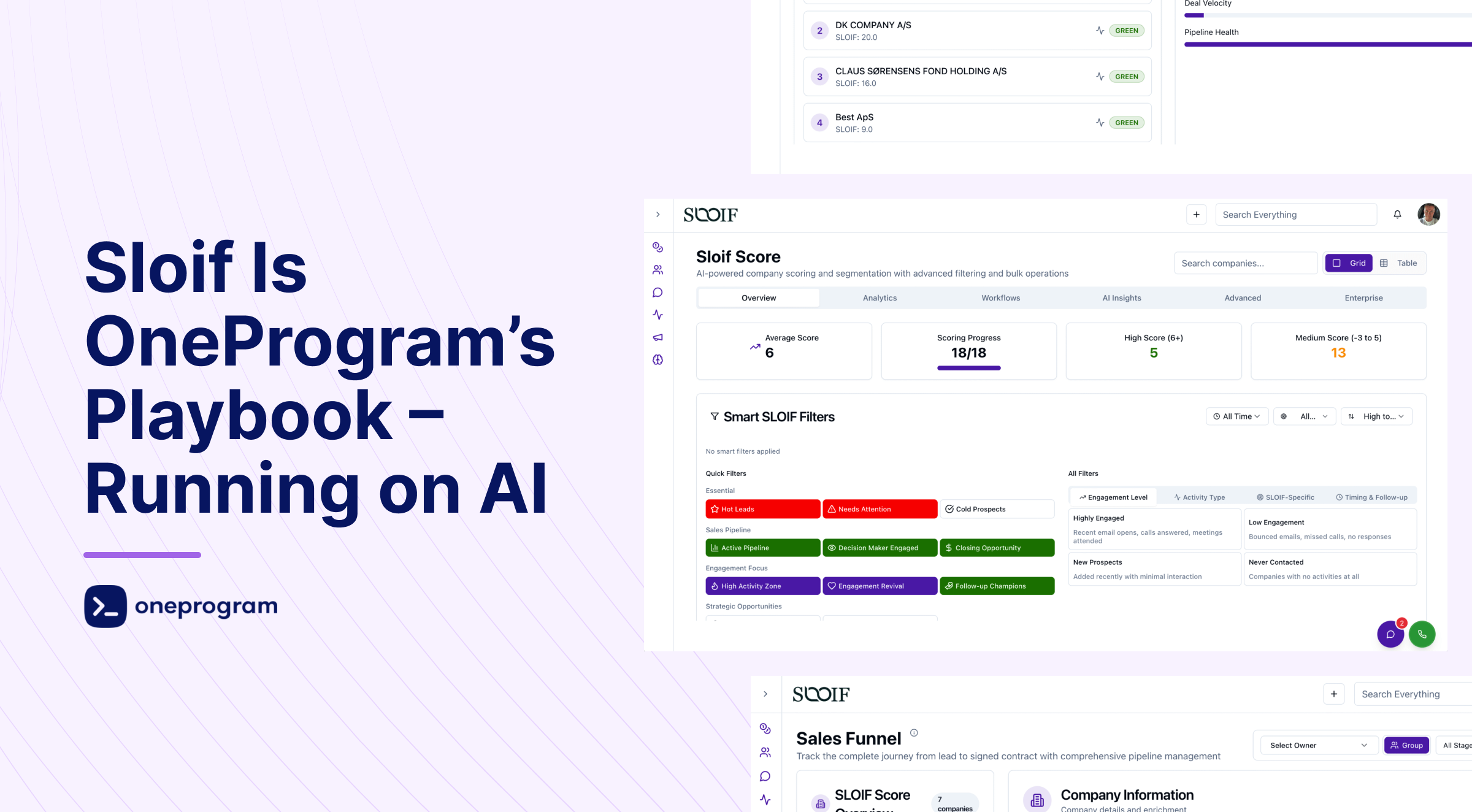
Shareable modules → AI as a reusable growth engine
OneProgram’s “development-oriented culture with shareable modules as the key innovations” makes reuse a strategy, not a convenience. Sloif fits this exactly. Rather than ripping out a company’s stack, Sloif plugs in and supplies reusable AI capabilities—lead intelligence, forecasting, activity orchestration, and an AI pitch generator—that any portfolio product can adopt with minimal lift. In practice, Sloif’s feature set acts like a cross-portfolio accelerator: a standard dashboard, consistent scoring, and repeatable pipelines that can be cloned across teams and ventures.
Founder-first, human-in-the-loop
OneProgram centers passionate founders and surrounds them with operator muscle—engineering, GTM, and shared infrastructure—without displacing their ownership. Sloif mirrors that stance: it augments people rather than automating them away. Sellers and founders stay in control while the platform surfaces what matters—real-time opportunity scores, distilled insights from dialogues, and suggested arguments when it’s time to move a deal. Users describe it as a “superpower,” because the right talk-track is ready when the moment arrives—exactly the kind of leverage OneProgram wants tools to provide.
Metrics before narratives
At OneProgram, the first slide is the metrics dashboard, not the vision board; ARR, LTV, churn, CAC payback and ACS are the operating language. Sloif turns messy, qualitative go-to-market activity into metrics that snap into that language. Its Complete Dashboard instruments real-time analytics, revenue insights, pipeline health, and conversion trends—so teams can see the impact of a new message or pricing change in the numbers, not just anecdotes. The result is a tighter loop between message, market signal, and the three numbers OneProgram wakes up to every day.
Customer-led communication at scale
OneProgram urges founders to talk in solutions tuned to each persona—leadership, sales, marketing, IT—rather than reciting feature lists. Sloif operationalizes that mindset. The AI Pitch Generation feature produces role-aware messaging from your own CRM evidence, and Digital Salesrooms turn those messages into living proposals prospects can review and advance asynchronously. Instead of guessing which line resonates, teams ship copy backed by conversation data and watch engagement right inside the deal.
Onboarding and operations, systematized
Onboarding quality is the hinge between sign-up and LTV, and OneProgram treats it as “the most critical phase” in SaaS. Sloif’s Activity Management (tasks, meetings, follow-ups) and stage-based automation reduce dropped balls in the first 30–60 days, when adoption risk is highest. Contact & Company Management with business-register enrichment and duplicate detection keeps accounts clean so what Sales promises is what Success can deliver—closing the loop OneProgram cares about: acquire, onboard, expand.
Portfolio synergy and knowledge compounding
A core OneProgram advantage is the shared tech and go-to-market engine across companies. Sloif makes this tangible. Because the scoring model and pipelines are consistent, patterns learned in one domain (say, an objection-buster that moves mid-market deals) can be templated and reused by another team with a similar motion. That compounds learning speed and compresses the time between “we think this message works” and “the dashboard shows it works.”
Capital efficiency and exit readiness
OneProgram prizes capital efficiency and exit discipline, anchored by an operating cadence around ARR/MRR bridges, segmented churn, CAC payback and ACS. Sloif contributes on both fronts. First, it functions as an overlay—you keep your CRM while Sloif imports data and layers insight—so payback comes from smarter conversion and expansion without a costly platform swap. Second, by standardising instrumentation (e.g., dashboards that match the OneProgram metric stack), Sloif feeds the diligence package buyers expect, well before a process starts—strengthening the company whether you exit soon or keep compounding.
What the AI actually does
Under the hood, Sloif analyses all customer dialogues—emails, notes, calls—and weights statements as positive, neutral or negative to explain why customers buy (or don’t). In the UI, you’ll find:
SLOIF AI – Lead Intelligence: AI-powered lead scoring with predictive analytics, ICP validation, competitive cues and explainable scores.
- Complete Dashboard: real-time analytics and performance widgets for revenue and pipeline.
- Contact & Company Management: unified parties with enrichment (incl. CVR/business register) and dupe detection.
- Multiple Pipelines: unlimited, drag-and-drop stages with stage-specific automation and templates.
- Sales Forecasting: AI-assisted revenue projections and trend analysis.
- Activity Management: tasks, meetings and follow-up reminders with analytics.
- Digital Salesroom and AI Pitch Generation to turn insights into action with proposals and role-aware messaging.
Across early adopters, Sloif reports ~30% sales lift after rollout—the kind of uplift you get when insight closes the gap between leads and language.
How to deploy the OneProgram × Sloif loop
- Connect your CRM and ingest history; keep your existing tools (Sloif can import from current CRMs).
- Instrument the metric stack: put ARR/MRR bridges, CAC payback and net retention next to Sloif’s conversion and engagement metrics.
- Ship solution-led copy with the pitch generator; validate it inside the Salesroom.
- Coach the frontline with score explanations and objection patterns.
- Tighten onboarding via activity automation in the risky first 60 days.
- Template wins across the portfolio; reuse pipelines, arguments and dashboards.
Sloif doesn’t change OneProgram’s strategy—it accelerates it. By pairing founder-first company building with an AI layer that measures what matters and suggests what works, the portfolio compounds faster, with cleaner cohorts and sharper messaging. That’s the OneProgram way, now with an engine that learns.
